Canford School
Coordinates: 50°47′23″N 1°57′14″W / 50.7898°N 1.9538°W
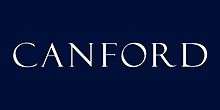 | |
| Motto |
Latin: Nisi Dominus Frustra Unless the Lord in Vain |
|---|---|
| Established | 1923 |
| Type |
Independent school Public school |
| Head Master | Ben Vessey |
| Location |
Canford Magna Wimborne Dorset BH21 3AD England |
| DfE URN | 113922 Tables |
| Staff | c. 100 |
| Students | 632 |
| Gender | Co-educational |
| Ages | 13–18 |
| Houses | 10 |
| Colours | Blue & White |
| Publication | The Canfordian, Canford News |
| Alumni | Old Canfordians |
| Website |
www |
Canford School is a coeducational independent school for both day and boarding pupils aged 13 to 18. The school is situated in 300 acres of parkland near to the market town of Wimborne Minster in Dorset, south west England. The school provides opportunities for a wide variety of sports and leisure activities.
The school is as a Headmasters' and Headmistresses' Conference (HMC) school. Referred to as a "public school", Canford charges up to £11,171 per half.[1] Canford is the 11th most expensive HMC day school and 19th most expensive HMC boarding school in the UK.[2] The school is rated outstanding by Ofsted and is consistently ranked among the best co-educational independent schools nationally. In 2014, Canford was voted 'Public School of the Year'.[3]
The school has an enrolment of 630 students spread across seven boarding and three day houses. Its alumni include foreign statesmen, former and current members of both houses of the British Parliament as well as members of various royal families. Canford School count among their alumni high-ranking military officers, pioneers in industry, computing, and economics in addition to figures in the Arts and Sciences.
History
Canford Manor traces its history back to the Saxon period, but rose to prominence during the early medieval period being, at various times, part of the estate of the Earl of Salisbury, the Duchy of Lancaster and the Crown.[4]
Of that early period, only the Norman church and 14th century refectory known as John O' Gaunt's Kitchen. The main building is much later and was designed by Edward Blore and Sir Charles Barry during the 19th century. It is a Grade I listed building.[4]
Assyrian frieze
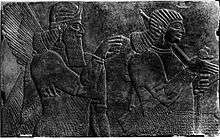
In 1992, a lost Assyrian stone relief was rediscovered on the wall of "the Grubber" (the school tuck shop).[5] The relief was sold by Christie's at auction in 1994 for £7.7 million (US$11.9 million), by far the highest price that had been paid at the time for an antiquity. Although it is at first sight rather unlikely that such a valuable item should be found on the wall of a school tuck shop, the history of the school explains how the relief came to be there. It had been brought back from the site of Nimrud in northern Mesopotamia (Iraq) by Sir Austen Henry Layard along with other antiquities which were displayed at Canford before it was a school. Originally Canford had been a private country house (known as Canford Manor), designed by Edward Blore and improved by Sir Charles Barry, and the residence of Layard's cousin and mother-in-law, Lady Charlotte Guest and her husband, Sir John Josiah Guest. At that time, the building now known as the Grubber had been used to display antiquities and was known as "the Nineveh Porch". It was however believed by the school authorities to be a plaster copy of an original which had been lost overboard during river transit and little attention was paid to it after the school was established. A dartboard was even hung in the Grubber close to where the frieze was displayed. It was John Russell of Columbia University who identified the frieze as an original, one of a set of three relief slabs taken from the throne room of Assyrian King Assurnasirpal II (883–859 BC). A new plaster copy now stands in the foyer of the Layard Theatre at Canford and a number of "Assyrian Scholarships" are available, funded from the sale proceeds which also helped pay for the construction of a new sports facility.
The original relief is now part of the collection of the Miho Museum in Japan.[6][7]
School fees cartel (2005)
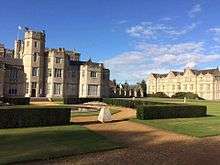
In 2005, the school was one of fifty of the country's leading private schools which were found guilty of running an illegal price-fixing cartel, exposed by The Times, which had allowed them to drive up fees for thousands of parents.[8] Each school was required to pay a nominal penalty of £10,000 and all agreed to make ex-gratia payments totalling three million pounds into a trust designed to benefit pupils who attended the schools during the period in respect of which fee information was shared.[9] However, Mrs Jean Scott, the head of the Independent Schools Council, said that independent schools had always been exempt from anti-cartel rules applied to business, were following a long-established procedure in sharing the information with each other, and that they were unaware of the change to the law (on which they had not been consulted). She wrote to John Vickers, the OFT director-general, saying, "They are not a group of businessmen meeting behind closed doors to fix the price of their products to the disadvantage of the consumer. They are schools that have quite openly continued to follow a long-established practice because they were unaware that the law had changed."[10]
Health
In March 2006, the school suffered an outbreak of Legionnaires' disease though only two students were affected.[11]
Overview
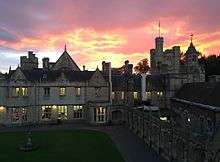
In 1923, the school was founded when the manor was purchased from Lord Wimborne.[4] It is located in 300 acres of ground on the banks of the River Stour. There are approximately 630 pupils at Canford, organised into houses and ranging in age from 13 to 18. Currently,(2014) 5% of students in the school are foreign nationals. Ben Vessey is the Headmaster; Richard Knott is the Second Master. The Daily Telegraph ranked it in the top five co-educational boarding schools in the United Kingdom at A Level in 2013.
House system
Canford has seven boarding houses and three day houses. Each house has a married housemaster/mistress, three tutors (one resident in each boarding house) and at least one house matron. House year groups vary between 10–15 pupils and each community numbers 60–65.
Boys:
- School House
- Court House
- Franklin House
- Monteacute House
Girls:
- Beaufort House
- Marriotts House
- de Lacy House
Mixed (Day):
- Wimborne House
- Salisbury House
- Lancaster House
Facilities
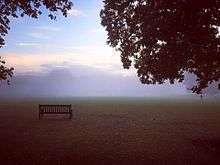
The school is set in a picturesque landscape with sport and theatre dominating the facilities which are at Canford. Nevertheless, Canford is also home to one of the largest music schools in the country alongside a vast library.
Sport
During both the Michaelmas and Lent Halves Rugby and Hockey are major sports. The Summer Half, is dominated by cricket, athletics and rowing. The school frequently fields pupils as national entries in international competitions.
Canford offers an extensive range of facilities for their pupils' enjoyment, boasting over 300 acres of grounds. Canford is home to one of the few Real Tennis courts remaining in the United Kingdom [12] alongside a nine hole golf course [13] and a boathouse on the River Stour. The school also has one of the largest sports halls in the region [14] with space for simultaneous sports; having either current or former international representational in badminton, volleyball, indoor bowls, five-a-side football, cricket, table tennis, basketball, indoor hockey, trampolining and gymnastics. This is in addition to a comprehensively equipped fitness suite, two AstroTurf pitches and numerous tennis courts alongside a 25m heated indoor swimming pool.
The Layard Theatre
The Layard Theatre is situated inside Canford School and is open to the public.[15] It seats 299 people and can also cater for those who are restricted to a wheelchair. It was opened by Sir Richard Eyre in May 1999, and was part-funded from the £7.7 million achieved through the sale of an Assyrian relief (see below), originally brought to Canford when it was a private house by Sir Austen Henry Layard in the mid-19th century.
Nick Gorman, who taught art at Canford from 1997–2000, was commissioned to design the logo for the Layard Theatre.
Societies
The school places an emphasis of its societies on humanities. 'Politicos' is the departmental society relating to politics and is heavily revered among other independent schools.[16]
Old Canfordians
- The Very Reverend Henry Lloyd (1911–2001), Anglican priest, Dean of Truro
- Stephen Ward (1912–1963), osteopath involved in the Profumo Affair
- Hector Maclean (1913–2007), decorated RAF officer during Battle of Britain
- Sir George Clark, 3rd Baronet DL (1914–1991), Unionist politician in Northern Ireland
- Sir Ralph Verney, 5th Baronet KBE, DL (1915-2001) British Army Officer and Politician
- Sir Ashley Bramall (1916–1999), leader of the Inner London Education Authority, 1970–1981
- Charles Maclean of Duart, Baron Maclean (1916–1990), Chief Scout of the United Kingdom, 1959–1971, Chief Scout of the Commonwealth, 1959–1975, and Lord Chamberlain, 1971–1984
- Lieutenant Colonel Hilary Hook (1917–1990), Soldier and 'Home from the Hill' star
- Ted Cooke-Yarborough (1918–2013) physicist and WW2 radar and computer pioneer[17]
- Paul Feiler (1918-2013), abstract artist
- Mike Randall (1919–1999), editor of the Daily Mail and Sunday Times
- David Sheldrick (1919–1977), Anglo-Kenyan conservationist
- John Barnes (1920-2008), Historian
- Rear Admiral John Templeton-Cotill (1920-2011), Naval Officer
- Hector Monro, Baron Monro of Langholm (1922–2006), Conservative politician
- Stuart Symington (1926–2009), cricketer
- John Douglas, 21st Earl of Morton (1927–2016), Deputy Lieutenant of West Lothian
- Michael Ash (1927), Mathematician, brewer, and inventor of the Easy Serve Draught Guinness
- Michael Medwin (born 1929), actor
- Rutherford Aris (1929–2005), chemical engineer, Regents Professor Emeritus
- David Littman (born 1933), historian and human rights advocate
- Sir John Drummond (1934–2006), arts administrator, former controller of BBC Radio 3
- General Sir Brian Kenny (born 1934)
- Second Lieutenant Paul Benner GC (1935–1957), awarded the George Cross
- Stan Brock (1936), television presenter, philanthropist
- Air Chief Marshal Sir Roger Palin (born 1938)
- Simon Preston CBE (born 1938), organist, conductor, composer
- Stephen Rubin OBE (born 1938), founder of Pentland Industries (Hunter, Speedo, Berghaus, Ellesse, etc.)
- Derek Jarman (1942–1994), film director and gay rights activist
- Ian Bradshaw (born 1940s), photographer and winner of the World Press Photo Award
- Sir Henry Cecil (1943–2013), champion race horse trainer
- Admiral Sir Ian Garnett (born 1944), naval officer
- Rear Admiral Sir Jeremy De Halpert KCVO, CB (born 1945), naval secretary
- Tim Stevenson (born 1948), Lord Lieutenant
- Simon Crowcroft (born 1950), Connétable of St Helier
- Alan Hollinghurst (born 1954), author
- Christopher Edward Berkeley Portman, 10th Viscount Portman (born 1958), British peer and property developer
- Owen Bennett-Jones, journalist, 'Newshour'
- Sir Philip Moor (born 1959), judge of the High Court of England and Wales
- Nigel Robertson (born 1962), entrepreneur, founder of FreePages plc
- Simon Hilton (born 1967), music video director
- Tom Holland, (born 1968), novelist and popular historian
- Stephen Phillips QC, MP (born 1970), Conservative politician
- Giles Duley (born 1971), photojournalist
- Miranda Cooper (born 1975), formerly the singer 'Moonbaby', songwriter and director of the company Xenomania
- William Villiers, 10th Earl of Jersey (born 1976)
- Yvonne Lui (born 1977), property magnate, philanthropist
- Nicholas Ashley-Cooper, 12th Earl of Shaftesbury (born 1979)
- Ben Gollings (born 1980), England rugby sevens player
- Alex Hibbert (born 1986), polar explorer
- Ore Oduba (born 1986), presenter and sports journalist
- Chloe-Jasmine Whichello (born 1991) Reality TV star
See also
- Bryanston School, Dorset
- Sherborne School, Dorset
References
- ↑ http://www.canford.com/fees.aspx?nid=c46c96ed-648c-4bcb-9058-a24231f2c7d6
- ↑ http://www.privateschoolfees.co.uk
- ↑ http://www.canford.com/newsarticles.aspx?id=1786
- 1 2 3 Our History at www.canford.com. Retrieved 4 Nov 2016.
- ↑ Russell, John Malcolm, ed. (1997). From Nineveh to New York: The strange story of the Assyrian reliefs in the Metropolitan Museum and the hidden masterpiece at Canford School. New Haven/London: Yale University Press; New York: The Metropolitan Museum of Art.
- ↑ McKenzie, Judith (1997). "10". Canford School. Russell. pp. 173–189.
- ↑ Paley, Samuel M. (1999). "A winged genius and royal attendant from the Northwest Palace at Nimrud". Bulletin of the Miho Museum. 2: 17–29, Plate 1.
- ↑ "Independent schools face huge fines over cartel to fix fees". The Times. UK. 2005.
- ↑ "The Office of Fair Trading: OFT names further trustees as part of the independent schools settlement". UK: Office of Fair Trading. 2006. Archived from the original on 10 June 2008.
- ↑ "Private schools send papers to fee-fixing inquiry". The Daily Telegraph. London. 3 January 2004. Retrieved 4 March 2014.
- ↑ "Legionnaires' hits public school". BBC News. UK: BBC. 9 March 2006.
- ↑ http://www.canford.com/real-tennis.aspx
- ↑ http://www.canford.com/golf.aspx
- ↑ http://www.canford.com/sports-centre.aspx?nid=192153f8-e43f-4213-9d77-c5616294b1bb
- ↑ "Layard Theatre". Theatres Online. Retrieved 2 June 2014. External link in
|publisher=(help) - ↑ http://www.canford.com/Politicos-Society.aspx
- ↑ "Obituaries: Ted Cooke-Yarborough". The Daily Telegraph. London. 4 April 2013. Retrieved 5 April 2013.